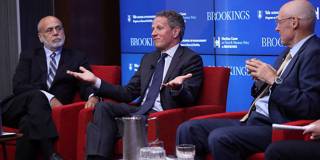After World War II, Winston Churchill confidently asserted that history would treat him kindly because “I propose to write that history.” Now, a decade after the global financial crisis, three of the key players in that episode have co-authored a book that is interesting not so much for its treatment of the past as for its proposals for the future.
EDINBURGH – Journalists, the adage goes, write “the first rough draft of history.” It’s a grand claim, but perhaps the best of them achieve something close to that. In the case of the Great Financial Crisis of 2008, Andrew Ross Sorkin of The New York Times did so in his book Too Big to Fail, which remains a useful description of how it felt on Wall Street when the markets began to collapse. Sorkin had good access to the key people involved.
The second draft of history is often written by the key people themselves. After World War II, Winston Churchill confidently asserted that history would treat him kindly because “I propose to write that history.” When the financial crisis erupted, the same thought may have crossed the minds of Hank Paulson, Ben Bernanke, and Tim Geithner, who were US Treasury Secretary, Chairman of the Federal Reserve Bank, and President of the New York Fed, respectively. All three published lengthy memoirs explaining why they did, and didn’t, do what they did and didn’t do – inevitably, with a degree of self-justification in each case.
Now, a decade later, the three of them have co-authored what might be described as version 2.1 of that episode’s history. At the cost of far fewer trees, Firefighting: The Financial Crisis and Its Lessons briefly summarizes the conclusions they now draw.

EDINBURGH – Journalists, the adage goes, write “the first rough draft of history.” It’s a grand claim, but perhaps the best of them achieve something close to that. In the case of the Great Financial Crisis of 2008, Andrew Ross Sorkin of The New York Times did so in his book Too Big to Fail, which remains a useful description of how it felt on Wall Street when the markets began to collapse. Sorkin had good access to the key people involved.
The second draft of history is often written by the key people themselves. After World War II, Winston Churchill confidently asserted that history would treat him kindly because “I propose to write that history.” When the financial crisis erupted, the same thought may have crossed the minds of Hank Paulson, Ben Bernanke, and Tim Geithner, who were US Treasury Secretary, Chairman of the Federal Reserve Bank, and President of the New York Fed, respectively. All three published lengthy memoirs explaining why they did, and didn’t, do what they did and didn’t do – inevitably, with a degree of self-justification in each case.
Now, a decade later, the three of them have co-authored what might be described as version 2.1 of that episode’s history. At the cost of far fewer trees, Firefighting: The Financial Crisis and Its Lessons briefly summarizes the conclusions they now draw.